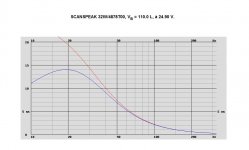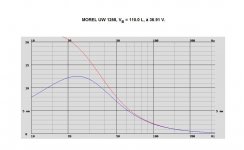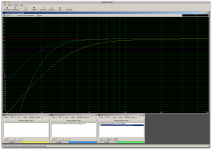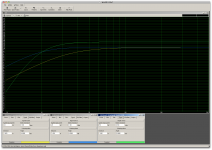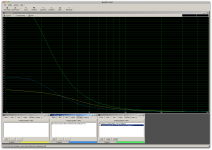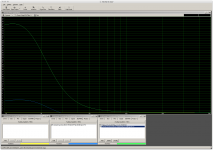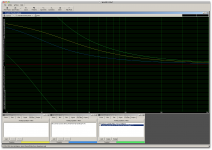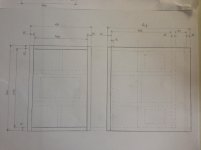Hi all,
First of all: let me start by telling you all that I have little to no experience in loudspeaker design and building. I know a few things about the theory and I have a pair of good ears, but no practical experience. I have a 10" subwoofer, but I'd like something bigger and beefier. What I think I want is very expensive when bought in a store, so I thought I'd check the DIY route. I have a plan (several, actually), but I'm not sure which will work best. I'd like some insights from experienced builders.
My current Adam Sub10 mkII does fine with music, although I'd like some more extension. I get 25Hz, but only just. I had to seal the sub to get it to intergrate well, but it's efficiency in the range where I need it most (sub 40Hz), is really low because of that. It manages 75dB at ca 25Hz before distorting like mad. So movies a bit louder than usual, is a problem.
I'd like a sub that works best with music: quick, deep extension, low distortion, high headroom. HT-use is of equal importance, but I prefer accuracy over grunt. Since my current sub sounds okay but really can't keep up with my Dynaudio Special 25's with movies, something with more power, headroom and extension is very welcome.
I'm looking at two drivers, both have good specs, as far as I can tell. They are the Morel UW1258 and the ScanSpeak 32W4878T00. Both suited for subwoofer duty, I believe. I've run a few simulations in WinISD, but I'm not sure how to relate them to real-world results.
With different alignments, I get different results, obviously. On one hand there is low group delay at around 30Hz (higher at 20Hz), which I think is good for speed (preferable for music). But these alignments lack deep extension. -3dB at ca 40Hz. I think 12" and 13" drivers should be able to do better. I can get lower bass from these simulations, but that results in enourmous boxes, of up to 250 liters!
On the other hand there are alignments with extension to 20Hz or so, but these have high group delay, of more than 30ms at around 25Hz. Less suited for music, but poweful and deep bass. Boxes of 140 - 150 liters.
According to SPL simulation, some 200Watts should be enough to get 105+ dB at is lowest useable frequency. But this 200 Watts wil cause the Morel driver to exceed it's Xmax in the deep bass alignment. 100W will prevent this, but I wonder if with 100W I'll still have headroom and dynamics.
Bottom line: how should I interpret these numbers? Will a box with low group delay and -3dB at ca40Hz deliver deep bass to ca 20Hz in a typical (Dutch) living room of ca 35m^2 using room gain? Or should I really aim for 20Hz f3? How should I interpret the SPL data? Is that comparable with reality? E.g. if WinISD says a box can manage 105dB at 20Hz, will it really do 105dB at 20Hz when it's built and up and running?
These questions are the first that came up. Ultimately I'd like to build a box that gets me quick, deep and powerful bass. But on the other hand: there are some space restrictions...
I hope somebody guide me in the right direction with this.
Thanks!
James.
PS: perhaps totally useless to mention, but boominess is a definite "no go". How, based on the simulations, can one predict if a subwoofer wil sound boomy? Has that to do with resonances in the port(s)?
First of all: let me start by telling you all that I have little to no experience in loudspeaker design and building. I know a few things about the theory and I have a pair of good ears, but no practical experience. I have a 10" subwoofer, but I'd like something bigger and beefier. What I think I want is very expensive when bought in a store, so I thought I'd check the DIY route. I have a plan (several, actually), but I'm not sure which will work best. I'd like some insights from experienced builders.
My current Adam Sub10 mkII does fine with music, although I'd like some more extension. I get 25Hz, but only just. I had to seal the sub to get it to intergrate well, but it's efficiency in the range where I need it most (sub 40Hz), is really low because of that. It manages 75dB at ca 25Hz before distorting like mad. So movies a bit louder than usual, is a problem.
I'd like a sub that works best with music: quick, deep extension, low distortion, high headroom. HT-use is of equal importance, but I prefer accuracy over grunt. Since my current sub sounds okay but really can't keep up with my Dynaudio Special 25's with movies, something with more power, headroom and extension is very welcome.
I'm looking at two drivers, both have good specs, as far as I can tell. They are the Morel UW1258 and the ScanSpeak 32W4878T00. Both suited for subwoofer duty, I believe. I've run a few simulations in WinISD, but I'm not sure how to relate them to real-world results.
With different alignments, I get different results, obviously. On one hand there is low group delay at around 30Hz (higher at 20Hz), which I think is good for speed (preferable for music). But these alignments lack deep extension. -3dB at ca 40Hz. I think 12" and 13" drivers should be able to do better. I can get lower bass from these simulations, but that results in enourmous boxes, of up to 250 liters!
On the other hand there are alignments with extension to 20Hz or so, but these have high group delay, of more than 30ms at around 25Hz. Less suited for music, but poweful and deep bass. Boxes of 140 - 150 liters.
According to SPL simulation, some 200Watts should be enough to get 105+ dB at is lowest useable frequency. But this 200 Watts wil cause the Morel driver to exceed it's Xmax in the deep bass alignment. 100W will prevent this, but I wonder if with 100W I'll still have headroom and dynamics.
Bottom line: how should I interpret these numbers? Will a box with low group delay and -3dB at ca40Hz deliver deep bass to ca 20Hz in a typical (Dutch) living room of ca 35m^2 using room gain? Or should I really aim for 20Hz f3? How should I interpret the SPL data? Is that comparable with reality? E.g. if WinISD says a box can manage 105dB at 20Hz, will it really do 105dB at 20Hz when it's built and up and running?
These questions are the first that came up. Ultimately I'd like to build a box that gets me quick, deep and powerful bass. But on the other hand: there are some space restrictions...
I hope somebody guide me in the right direction with this.
Thanks!
James.
PS: perhaps totally useless to mention, but boominess is a definite "no go". How, based on the simulations, can one predict if a subwoofer wil sound boomy? Has that to do with resonances in the port(s)?
Last edited:
Do you have a crossover/processor, and amplification?
PS - I had good results using an under-sized ported box and applying EQ to boost around port tuning to get a flat response. Beware power issues, though - impedance and cone excursion are at a minimum, so the drivers will have to have good thermal management.
PS - I had good results using an under-sized ported box and applying EQ to boost around port tuning to get a flat response. Beware power issues, though - impedance and cone excursion are at a minimum, so the drivers will have to have good thermal management.
Last edited:
The other way around (no EQ) you can use the ScanSpeak 32W4878T00 but not in a sealed enclosure. F-3dB 27Hz more like not 40Hz as you mention. I wouldn't consider that ""lack deep extension"".
Voice Coil specs
Madisound alignments link
You should use passive radiators better for best performance. Very long ports is not desirable. 2 passives for each 13" driver is an option.
ScanSpeak 30W/0-00 12" Passive
Passive Radiators
Dynaudio Special Twenty-Five loudspeaker Measurements | Stereophile.com
You can always opt for a different woofer (or longer 1M ports) if you don't like the passives alternative.
You can use the Morel Ultimate UW1258 working as above (EQ or not) it has plenty of excursion but in reality is 5 dB's (sensitivity) less than the SS.
Voice Coil specs
Madisound alignments link
You should use passive radiators better for best performance. Very long ports is not desirable. 2 passives for each 13" driver is an option.
ScanSpeak 30W/0-00 12" Passive
Passive Radiators
You can plug the reflex in the mains and get better summation with sub at crossover frequency (100/150Hz).When should I use a passive radiator? With what woofer?
Use a passive radiator when you would like to have the extra output of a vented system, but are not able to fit an adequate port into the enclosure. The tuning of a PR is determined by the amount of mass on the diaphram, where the tuning of a port is determined by length. Often if you want to get low tuning in a small enclosure, an adequate port will just not fit. You either need to sacrifice output by going with a smaller diameter port, or sacrifice low end extension by going with a higher tuned port. For example, we use a single 15" woofer in an enclosure tuned to 20Hz with a pair of 18" PR's. If you wanted to get the same tuning with an adequate port, it would need to be 6" diameter and nearly 60" long and you would STILL have problems with vent noise.
You typically only want to use a passive radiator along with a woofer that is designed for a vented enclosure. A passive radiator enclosure is NOT a sealed box enclosure. You will typically want to use a lower Q woofer with a PR system. This usually means a woofer with Qts of .4 or lower.
link
Dynaudio Special Twenty-Five loudspeaker Measurements | Stereophile.com
You can always opt for a different woofer (or longer 1M ports) if you don't like the passives alternative.
You can use the Morel Ultimate UW1258 working as above (EQ or not) it has plenty of excursion but in reality is 5 dB's (sensitivity) less than the SS.
Go with a sealed box for the best sound quality, and add a custom, diy Linkwitz transform EQ to make flat response.
How: Make a box as big as your wife will allow, to minimize the amount of power you'll need for bass boost EQ. If big is bad, then make it small, no problem, the EQ can make it behave and sound like a big box, but it will take more amp power and a higher driver power rating. So pick a driver that has high sensitivity and high power rating and strong cone construction, like a quality pro-audio bass guitar speaker. Eminence Alpha need not apply. The hifi speakers you mentioned will work fine. Build the box, install the speaker and use woofertester to measure the speaker/box parameters to get the values you need to calculate the transform filter parts values. Use the calculator, info and PCBs here to build your custom EQ for $50-75. You could also use a commercial EQ box like Behringer DEQ2496 or miniDSP with a SPL meter to create the FR you want but they are expensive for this simple job and you want to diy it anyway, right?
If you don't want no stinkin electronic EQ, then you will need a big box that can naturally make Qts=.57 with a big enough driver cone that works with the bass boosting reflections of the room to yield a net flat bass response. Rolloff of sealed box is -12dB/oct, while bass boost of room is +12dB/oct, so if you get the right rolloff slope (Qts) and big enough cone to start the rolloff at the right freq, then you end up with flat FR - in room. Smaller cone for smaller rooms. Use a free speaker box designer software like "WinISD Beta" to determine the desired Qts for a given box volume and driver parameters.
A low Qts will boost the bass at LF for more sensitivity, but it also improves the transient response, making the bass sound drier, faster and clearer, at cost of size, weight and more wood. Qts=.57 is an ideal value for sound quality if you can tolerate the big box. The lowest Q is .5, most people think that sounds too dry and the box is too big. Qts = .7 would be the smallest box for high sound quality, but with a linkwitz transform, up to Q=1 is OK.
Remember, the box volume (Vb) does not include the internal volume displaced by the driver protruding into the box, nor the internal box bracing, but Vb does include the volume occupied by soft stuffing.
The larger the box, the more difficult it is to prevent it from flexing and resonating from the pressure and vibration of the driver. If it flexes a lot, like it will with no bracing, you will hear it and you will hate it. The braces should connect opposite and adjacent faces, not just beams glued to the inside panels. That's another benefit of Linkwitz transform: it allows the same sound from a smaller box which is easier to prevent flex and vibration.
A 250W plate amp should do the job if you use Linkwitz Transform bass boost, with listening peaks of bass around 100dB in a medium size room. That's very loud for bass. Good luck!
Rich
How: Make a box as big as your wife will allow, to minimize the amount of power you'll need for bass boost EQ. If big is bad, then make it small, no problem, the EQ can make it behave and sound like a big box, but it will take more amp power and a higher driver power rating. So pick a driver that has high sensitivity and high power rating and strong cone construction, like a quality pro-audio bass guitar speaker. Eminence Alpha need not apply. The hifi speakers you mentioned will work fine. Build the box, install the speaker and use woofertester to measure the speaker/box parameters to get the values you need to calculate the transform filter parts values. Use the calculator, info and PCBs here to build your custom EQ for $50-75. You could also use a commercial EQ box like Behringer DEQ2496 or miniDSP with a SPL meter to create the FR you want but they are expensive for this simple job and you want to diy it anyway, right?

If you don't want no stinkin electronic EQ, then you will need a big box that can naturally make Qts=.57 with a big enough driver cone that works with the bass boosting reflections of the room to yield a net flat bass response. Rolloff of sealed box is -12dB/oct, while bass boost of room is +12dB/oct, so if you get the right rolloff slope (Qts) and big enough cone to start the rolloff at the right freq, then you end up with flat FR - in room. Smaller cone for smaller rooms. Use a free speaker box designer software like "WinISD Beta" to determine the desired Qts for a given box volume and driver parameters.
A low Qts will boost the bass at LF for more sensitivity, but it also improves the transient response, making the bass sound drier, faster and clearer, at cost of size, weight and more wood. Qts=.57 is an ideal value for sound quality if you can tolerate the big box. The lowest Q is .5, most people think that sounds too dry and the box is too big. Qts = .7 would be the smallest box for high sound quality, but with a linkwitz transform, up to Q=1 is OK.
Remember, the box volume (Vb) does not include the internal volume displaced by the driver protruding into the box, nor the internal box bracing, but Vb does include the volume occupied by soft stuffing.
The larger the box, the more difficult it is to prevent it from flexing and resonating from the pressure and vibration of the driver. If it flexes a lot, like it will with no bracing, you will hear it and you will hate it. The braces should connect opposite and adjacent faces, not just beams glued to the inside panels. That's another benefit of Linkwitz transform: it allows the same sound from a smaller box which is easier to prevent flex and vibration.
A 250W plate amp should do the job if you use Linkwitz Transform bass boost, with listening peaks of bass around 100dB in a medium size room. That's very loud for bass. Good luck!
Rich
@ Chris661: I have a Rotel RSX-1067 and intend to use it's bass management to drive the subwoofer. I have my current sub hooked up to one of it's subwoofer outputs and that works okay. Only draw back is that the cross-over point can't be set lower than 40Hz on the AVR, no lower than 50 if I use the sub's LPF. I prefer the subwoofer to cover as small a frequency range as possible. At least: based on my current configuration.
@ Inductor: I've nor simulated boxes with PR's. I'm not familiar with that technology, and I'm guessing it will become too large and too expensive. For now, I'm focussing on ported, or sealed and possibly EQ'ed.
@ Richidoo: do I understand correctly that the Linkwitz Transform EQ only works with sealed boxes? How does the added gain affect X-max with regards to the extra amplifier power needed? I think I can't simulate that in WinISD. I'll try to post some pictures of the simulations I have in mind. If I'm completely off with them, please say so. As mentioned before, I'm ony just losing my virginity on this subject...
@ Inductor: I've nor simulated boxes with PR's. I'm not familiar with that technology, and I'm guessing it will become too large and too expensive. For now, I'm focussing on ported, or sealed and possibly EQ'ed.
@ Richidoo: do I understand correctly that the Linkwitz Transform EQ only works with sealed boxes? How does the added gain affect X-max with regards to the extra amplifier power needed? I think I can't simulate that in WinISD. I'll try to post some pictures of the simulations I have in mind. If I'm completely off with them, please say so. As mentioned before, I'm ony just losing my virginity on this subject...
Last edited:
Some pictures of the plans I have. Your comments, please.
Also please note the X-max curves (simulated at 200W input). How do I relate that to real-world situations? E.G. I put a 500W amp in them, EQ-them for 20Hz extension and play a bass-heavy movie loudly? Will the drivers be in danger of mechanical damage of overload? Other possibe issues that may arise?
Also please note the X-max curves (simulated at 200W input). How do I relate that to real-world situations? E.G. I put a 500W amp in them, EQ-them for 20Hz extension and play a bass-heavy movie loudly? Will the drivers be in danger of mechanical damage of overload? Other possibe issues that may arise?
Attachments
-
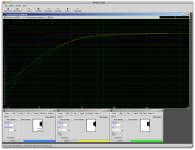 Morel UW1258 transfer function.png46.4 KB · Views: 542
Morel UW1258 transfer function.png46.4 KB · Views: 542 -
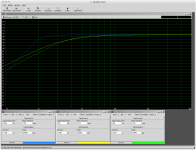 Morel UW1258 SPL 200W.png39.5 KB · Views: 540
Morel UW1258 SPL 200W.png39.5 KB · Views: 540 -
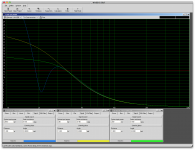 Morel UW1258 ConeX 200W.png45.2 KB · Views: 532
Morel UW1258 ConeX 200W.png45.2 KB · Views: 532 -
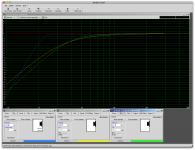 ScanSpeak 21W4878T00 transfer function.png48.8 KB · Views: 547
ScanSpeak 21W4878T00 transfer function.png48.8 KB · Views: 547 -
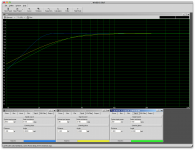 ScanSpeak 32W4878T00 SPL 200W.png44.9 KB · Views: 542
ScanSpeak 32W4878T00 SPL 200W.png44.9 KB · Views: 542 -
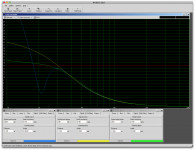 ScanSpeak 32W4878T00 ConeX 200W.png45.9 KB · Views: 87
ScanSpeak 32W4878T00 ConeX 200W.png45.9 KB · Views: 87
Lets' say you have both drivers in a sealed 110L enclosure, to make things easy.Also please note the X-max curves (simulated at 200W input). ...Will the drivers be in danger of mechanical damage of overload?
You apply high pass filters to both drivers to protect 200W at max excursion Xmax. In the first case for the MOREL UW1258 using a Butterworth 6 dB/octave (-3 dB)@27 Hz and in the second driver SCANSPEAK 32W/4878T00 a Butterworth 6 dB/octave (-3 dB)@19 Hz.
Spl is 108.3 dB in the first case and 110.1 dB in the second, for one driver/speaker/sub (1M), less ~2.8 dB for thermal att. (TA).
Attachments
@ Chris661: I have a Rotel RSX-1067 and intend to use it's bass management to drive the subwoofer. I have my current sub hooked up to one of it's subwoofer outputs and that works okay. Only draw back is that the cross-over point can't be set lower than 40Hz on the AVR, no lower than 50 if I use the sub's LPF. I prefer the subwoofer to cover as small a frequency range as possible. At least: based on my current configuration.
@ Inductor: I've nor simulated boxes with PR's. I'm not familiar with that technology, and I'm guessing it will become too large and too expensive. For now, I'm focussing on ported, or sealed and possibly EQ'ed.
@ Richidoo: do I understand correctly that the Linkwitz Transform EQ only works with sealed boxes? How does the added gain affect X-max with regards to the extra amplifier power needed? I think I can't simulate that in WinISD. I'll try to post some pictures of the simulations I have in mind. If I'm completely off with them, please say so. As mentioned before, I'm ony just losing my virginity on this subject...
Linkwitz transform only works with a sealed box.
Xmax is not related to power or gain. It's just a factor in determining max SPL at given freq. This calculator can help you focus on the drivers' capabilities. Piston Excursion Calculator
WinISD is most helpful for determining the Vb for desired Qts and a given driver specs.
Your preference for accuracy over grunt, and your desire for high SPL at low freq indicates that you would prefer a larger diameter cone. Going big has lots of benefits. 15-18"
Last edited:
My recommendation would be to go with the Scanspeak. This isn't to say that the Morel is going to be worse in spec, but Scan have a reputation for their drivers being very good. This is mainly because Klippel tests, at least with respect to linear excursion, are generally bang on spec for Scan drivers, whereas others seem to fall a little behind.
As we're comparing driver performance based on swept volume displacement, a driver actually being able to work up to its xmax spec, whilst being linear, is going to be pretty important and I would trust the Scan to do this more than the Morel.
It would be nice however to see a full set of measurements on some of Morels newer designs, just to see if they've improved somewhat. One things for certain though, Scan never needed to improve, they've always been top notch.
As we're comparing driver performance based on swept volume displacement, a driver actually being able to work up to its xmax spec, whilst being linear, is going to be pretty important and I would trust the Scan to do this more than the Morel.
It would be nice however to see a full set of measurements on some of Morels newer designs, just to see if they've improved somewhat. One things for certain though, Scan never needed to improve, they've always been top notch.
@ Richidoo: That's a nice link, thanks! X-max is not all that important in the bigger picture, but it is a limiting factor in achieving SPL at a given frequency. It seems that with the idea I have in mind the ScanSpeak should be able to achieve 90+ dB at 20Hz. That's more than I probably need. So it seems this could be a very nice subwoofer with pleny of headroom, if I manage to finish the project. But let's first focus on designing the thing...
The more you know, the more you don't seem to know...
Okay, I've come up with a box: sealed, with a (WinISD determined) Q=0.577 aligment. I've modified it slightly to 94 liters (Q=0.594) to make the internal dimensions easier to deal with. The frequency response then gives f3=40Hz, 20Hz is 10dB down (yellow line). Group delay is a very nice 8ms at 20Hz. When I add a Linkwitz Transform with fp=20Hz, I get f3=20Hz. Nice Group delay still is nice at 11ms. (blue line)
Group delay still is nice at 11ms. (blue line)
When I simulate 20Hz to give a +/- 100dB output, I need ca 50 Watts. But cone excursion is through the roof, with a whopping 21mm! 23 Watts keeps it just within it's limit, still delivering 97,8dB @ 1m.
Now, when I add a 4th order Linkwitz Riley HPF at 18Hz, f3=25.3Hz, Xmax will be reached at 21.2Hz with 50Watts input, max SPL at 20HZ is 97.7dB. However, 20Hz is 6.5dB down. And group delay increases to a huge 33.5ms @20Hz. That doesn't seem desirable... does it?
This is starting to look like nice sub, but I have a few questions. Because once again I'm not quite sure how to interpret all this.
First of all: will f3=20Hz result in much lower extension due to room gain? And if so: I suppose the frequency at which room gain start to work will depend on placement, room size, furniture present, treatment (if any), etc... Am I right?
Furthermore: adding an HPF will more or less protect the driver from working too hard in it's low efficiency-range way down low, but it also increases group delay AND pulls up f3. How bad is that in the bigger picture? When the aim is to build a musical sub that can produce clean, quick and real deep bass, will I need a (much) larger cabinet? Hope not!
Also: 97dB doesn't seem that loud. But how often will a 20Hz signal be played at 97dB when you're watching a movie? If the ULF component is 97dB loud, how loud will the rest be? also 97dB, or more like 110dB? If that's the case, I won't really need anything near as much as 80dB at 20Hz, and a 200W plate amp will be more than enough to shake my neighbours. But on the other hand: my current sub is set up to fill in only below 40Hz (mains doing full range), and this sub will probably do the same. I like a sub to cover as small a frequency range as possible. But that will also mean I'll need to feed it more power if it is to keep up with my mains. Basically, what I'm looking for is a flat in-room response down to very close to 20Hz, preferably lower. But how can I achieve that and still get some SPL and headroom from it? I doubt that will work in a 90 liter closed box...
Do you think this sub looks like a good recipe? I have my doubts about the HPF, because it increases group delay dramatically. But, again, I don't know if and how that will be heard...
Any insights?
Thanks!
James.
Okay, I've come up with a box: sealed, with a (WinISD determined) Q=0.577 aligment. I've modified it slightly to 94 liters (Q=0.594) to make the internal dimensions easier to deal with. The frequency response then gives f3=40Hz, 20Hz is 10dB down (yellow line). Group delay is a very nice 8ms at 20Hz. When I add a Linkwitz Transform with fp=20Hz, I get f3=20Hz. Nice
When I simulate 20Hz to give a +/- 100dB output, I need ca 50 Watts. But cone excursion is through the roof, with a whopping 21mm! 23 Watts keeps it just within it's limit, still delivering 97,8dB @ 1m.
Now, when I add a 4th order Linkwitz Riley HPF at 18Hz, f3=25.3Hz, Xmax will be reached at 21.2Hz with 50Watts input, max SPL at 20HZ is 97.7dB. However, 20Hz is 6.5dB down. And group delay increases to a huge 33.5ms @20Hz. That doesn't seem desirable... does it?
This is starting to look like nice sub, but I have a few questions. Because once again I'm not quite sure how to interpret all this.
First of all: will f3=20Hz result in much lower extension due to room gain? And if so: I suppose the frequency at which room gain start to work will depend on placement, room size, furniture present, treatment (if any), etc... Am I right?
Furthermore: adding an HPF will more or less protect the driver from working too hard in it's low efficiency-range way down low, but it also increases group delay AND pulls up f3. How bad is that in the bigger picture? When the aim is to build a musical sub that can produce clean, quick and real deep bass, will I need a (much) larger cabinet? Hope not!
Also: 97dB doesn't seem that loud. But how often will a 20Hz signal be played at 97dB when you're watching a movie? If the ULF component is 97dB loud, how loud will the rest be? also 97dB, or more like 110dB? If that's the case, I won't really need anything near as much as 80dB at 20Hz, and a 200W plate amp will be more than enough to shake my neighbours. But on the other hand: my current sub is set up to fill in only below 40Hz (mains doing full range), and this sub will probably do the same. I like a sub to cover as small a frequency range as possible. But that will also mean I'll need to feed it more power if it is to keep up with my mains. Basically, what I'm looking for is a flat in-room response down to very close to 20Hz, preferably lower. But how can I achieve that and still get some SPL and headroom from it? I doubt that will work in a 90 liter closed box...
Do you think this sub looks like a good recipe? I have my doubts about the HPF, because it increases group delay dramatically. But, again, I don't know if and how that will be heard...
Any insights?
Thanks!
James.
Attachments
Last edited:
Group delay increases when you add in the high pass filter because filters introduce delay/phase shifts, it's how they work and down so low can really just be ignored.
The bigger you make a sealed box, the more efficient a system becomes and the less input power it needs to reach a given SPL.
With regards to your comment on not really needing Xmax, this is entirely what a sub woofer is about, being able to shift lots of air and being able to produce lots of clean output at low frequencies. My comment on the Scan vs the Morel, is that Scan speaks expensive drivers have been shown to have real world linear xmax figures in line with what their specification actually shows. Others have not. I do not know if the Morel is going to be on point, but there is a good chance that it might fall foul by 30% or so. This is not uncommon, but given the choice I'd rather go with the Scan.
The bigger you make a sealed box, the more efficient a system becomes and the less input power it needs to reach a given SPL.
With regards to your comment on not really needing Xmax, this is entirely what a sub woofer is about, being able to shift lots of air and being able to produce lots of clean output at low frequencies. My comment on the Scan vs the Morel, is that Scan speaks expensive drivers have been shown to have real world linear xmax figures in line with what their specification actually shows. Others have not. I do not know if the Morel is going to be on point, but there is a good chance that it might fall foul by 30% or so. This is not uncommon, but given the choice I'd rather go with the Scan.
At 94 liters, with or without the HPF, the subwoofer looks to be able to output some 97dB at 20Hz, and much more at an octave higher. I suspect I won't even need so much power. Though it's certainly to have the headroom available. At that level, the amp will be supllying some 15Watts... Practically idling.
If I understand correctly, both the Linkwitz Transform EQ and the HPF are separate PCB's that go in front of the amplifier input. Is there a way to build in the HPF with the option to bypass it with a switch?
If I understand correctly, both the Linkwitz Transform EQ and the HPF are separate PCB's that go in front of the amplifier input. Is there a way to build in the HPF with the option to bypass it with a switch?
At 94 liters, with or without the HPF, the subwoofer looks to be able to output some 97dB at 20Hz, and much more at an octave higher. I suspect I won't even need so much power. Though it's certainly to have the headroom available. At that level, the amp will be supllying some 15Watts... Practically idling.
If I understand correctly, both the Linkwitz Transform EQ and the HPF are separate PCB's that go in front of the amplifier input. Is there a way to build in the HPF with the option to bypass it with a switch?
Just use a miniDSP and you can dial the Linkwitz transform or the HPF or anything else you desire on the fly. No PCB needs to be made, also acts as your XO. Highly recommended for experimenting and real world use.
At 94 liters, with or without the HPF, the subwoofer looks to be able to output some 97dB at 20Hz, and much more at an octave higher. I suspect I won't even need so much power. Though it's certainly to have the headroom available. At that level, the amp will be supllying some 15Watts... Practically idling.
SPL is caused by moving air, which means excursion times cone area. EQ and filters cannot affect this, it's just physics. From your first posts, it rather seemed you needed either bigger drivers or more stroke or more drivers. Anyway, the amount of air moved for a given SPL changes as the square of the frequency, so yeah at 40 Hz you need only 1/4 the excursion.
I'm not sure if 97 dB at 20 Hz is so much. The definitive paper about this is: Fielder, Louis D., Benjamin, Eric M.: " Subwoofer Performance for Accurate Reproduction of Music ", Journal of the Audio Engineering Society, Vol. 36, #6, June, 1988.
Essentially, they say that since human is insensitive to low frequencies, you have to produce some pretty high levels at low frequencies or you won't hear those frequencies anyway!
If I understand correctly, both the Linkwitz Transform EQ and the HPF are separate PCB's that go in front of the amplifier input. Is there a way to build in the HPF with the option to bypass it with a switch?
The Linkwitz is basically a shelf filter. If you put a HPF in series, then you rather end up with an EQ bump. The need for HPF at such a low frequency is debatable, since sealed boxes limit excursion inherently (unlike vented boxes).
The Transform relies on math-it is the inverse of the SUPPOSED rolloff of the sealed box. Which you calculate based on parameters. Which change depending on the measurement technique, the weather, how broken in the woofer is, the excursion level, the thermal heating of the voice coil…it's a neat mathematical trick, but hardly exactly correct. That doesn't mean it's a bad idea, just understand that on a micro scale it doesn't really work perfectly. And, are you taking room gain into account? That will modify the transfer function (frequency response) out of the speaker.
I don't remember about WinISD, but you can't get a truly accurate transfer function without more measurements than Thiele-Small. Those guys were geniuses, but as Dick Small reminded me once, his work was a SMALL*-signal simulation, not perfection, and not too valid once the woofer started to move very much.
(*ha ha, shoot me now!).
I *think* WinISD pretends the speaker is an electronic high pass filter, which is fine for gross work, but don't get too hung up on it as actual speakers won't measure like that. You need something like LEAP or a Klippel setup to make more accurate simulations. So don't worry about every 1/4 decibel or 3 Hertz change-that's not really what your woofer will do anyway. And in a sealed box, modest changes in box size won't affect the response much. Good stuffing (see Dickason's Loudspeaker Cookbook will make more difference, especially by absorbing upper frequencies.
In a vented box, to avoid boominess, my basic rule of thumb has been that the response should slowly droop. In other words, vaguely resemble a sealed box with a Qtc=0.5. Of course eventually the vented box rolls off more quickly at the bottom end, but if the rolloff starts slowly then I've been happy with the sound (and I'm VERY picky about boom).
Last edited:
Hmmmm... this is getting more and more confusing. There seem to be many more factors to take into account than I initially thought. Drawing up a decent design for a straight forward, strong and solidly braced cabinet shouldn't be that difficult. Although I hardly have any design tools (besides WinISD and a pair of good ears). Basically, it wouldn't be to too difficult to design the thing and build it. But then the real work starts: measuring and fine-tuning the thing to it's actual in-room performance - which, among other things, depends on placement and room acoustics.
The problem is that I don't have any measurement tools - just a simple, (probably uncalibrated) RTA-app on my iPhone. This same app displays info down to 25Hz (i think in 1/3 octave bands). It tells me that reproduction with my current setup and room, is pretty flat down to 25Hz, reaching levels to some 75 - 80dB. According to this app, I have a pretty much non-existant downwards slope from 100Hz down. I do not dare play any louder, since I doubt my current sub can handle that. But of course, the info from this app, should probably be taken with a few grains of salt.
My 10", once ported-now sealed sub, can manage 25Hz. My ears more or less confirm that (not sure about -3dB). I have no idea about the measured performance of my artificially sealed sub. Ported, it should easily do 25Hz (-3dB) - with massive chuffing. If the sub I'm designing manages -3dB @40Hz without help, it might reach below 20Hz with room gain. But how can I predict that? It would be rather pointless to build in a hardware Linkwitz Transform EQ and then find out that I'm boosting a frequency that's already boosted by the room. I like a well balanced and refined sound. Deep bass is good, but it should not be so loud that it shrouds the mids and highs.
A Mini-DSP enabled plate amp might be the perfect solution here, since it's completely customisable and allows for tweaking, depending on the acoustic environment. And it's not that expensive.
What will I need to determine the parameters that need to be adjusted to get the performance I need?
I doubt it will be much of a problem that WinISD doesn't *exactly* predict the real-world performance of a speaker, since I think the influence of room-acoustics will be bigger than the impact of such errors in the simulation. It that thought correct?
Edit: One could ask me why I bother with this, if I already seem to get decent deep-bass performance. The answer is: I think my subwoofer is overstretched in it's current configuration (wasn't designed to be used sealed, ported it doesn't match well with my current speakers). I also think it distorts too much. My current main speakers are so accurate and "clean", that any and all distortion higher than their own, is easily detected. And so my current sub seems to be the weak link.
The problem is that I don't have any measurement tools - just a simple, (probably uncalibrated) RTA-app on my iPhone. This same app displays info down to 25Hz (i think in 1/3 octave bands). It tells me that reproduction with my current setup and room, is pretty flat down to 25Hz, reaching levels to some 75 - 80dB. According to this app, I have a pretty much non-existant downwards slope from 100Hz down. I do not dare play any louder, since I doubt my current sub can handle that. But of course, the info from this app, should probably be taken with a few grains of salt.
My 10", once ported-now sealed sub, can manage 25Hz. My ears more or less confirm that (not sure about -3dB). I have no idea about the measured performance of my artificially sealed sub. Ported, it should easily do 25Hz (-3dB) - with massive chuffing. If the sub I'm designing manages -3dB @40Hz without help, it might reach below 20Hz with room gain. But how can I predict that? It would be rather pointless to build in a hardware Linkwitz Transform EQ and then find out that I'm boosting a frequency that's already boosted by the room. I like a well balanced and refined sound. Deep bass is good, but it should not be so loud that it shrouds the mids and highs.
A Mini-DSP enabled plate amp might be the perfect solution here, since it's completely customisable and allows for tweaking, depending on the acoustic environment. And it's not that expensive.
What will I need to determine the parameters that need to be adjusted to get the performance I need?
I doubt it will be much of a problem that WinISD doesn't *exactly* predict the real-world performance of a speaker, since I think the influence of room-acoustics will be bigger than the impact of such errors in the simulation. It that thought correct?
Edit: One could ask me why I bother with this, if I already seem to get decent deep-bass performance. The answer is: I think my subwoofer is overstretched in it's current configuration (wasn't designed to be used sealed, ported it doesn't match well with my current speakers). I also think it distorts too much. My current main speakers are so accurate and "clean", that any and all distortion higher than their own, is easily detected. And so my current sub seems to be the weak link.
Last edited:
http://www.diyaudio.com/forums/multi-way/241449-new-program-room-response-simulation.htmlWhat will I need to determine the parameters that need to be adjusted to get the performance I need?
I doubt it will be much of a problem that WinISD doesn't *exactly* predict the real-world performance of a speaker, since I think the influence of room-acoustics will be bigger than the impact of such errors in the simulation. It that thought correct?
At http://www.diyaudio.com/forums/subwoofers/62267-modeling-room-gain.html paulspencer says "I've seen a few different theoretical "room gain curves" with a nice neat curve... But when you see measurements from a real room you realise how pointless it is considering this curve. Add to your curve a 20 db peak at 35 Hz, then a 15 db dip at 55 then numerous peaks and dips between there and 200 Hz. It becomes difficult if not impossible to say if there is actually any gain now. If you eq out the lowest dip, you then find that your sub that is flat to 20 Hz anechoic now needs 12db of eq to reach 20 Hz flat in room! The room modes dominate. "...If the sub I'm designing manages -3dB @40Hz without help, it might reach below 20Hz with room gain. But how can I predict that? It would be rather pointless to build in a hardware Linkwitz Transform EQ and then find out that I'm boosting a frequency that's already boosted by the room.
So I think you have to decouple the topic of speaker response and room response somewhat. The speaker response to me is more about the sound-boomy versus tight, and a slow rolloff sounds better, and the -3 dB point does not matter very much. There is NOTHING magic about -3 dB! It was just a mathematical convenience for Richard Small's thesis. The -6 dB and -10 dB points are more important. All this leads to my preference for "undertuned" ported boxes (or sealed, but sealed just gives up a lot of output subwoofer situations, so you need special drivers and BIG amps)
Yes. What I meant, though, was to not get too obsessed with small changes in response out of a simulation with any electrical filter based speaker simulator, because it is ultra accurate anyway. I used to spend all kinds of time tweaking stuff and looking at tiny response changes, and it took some years to realize those tiny changes were meaningless. Those simple programs are fine for a head start, but then you have to build and line and stuff a good cabinet with a good driver.I doubt it will be much of a problem that WinISD doesn't *exactly* predict the real-world performance of a speaker, since I think the influence of room-acoustics will be bigger than the impact of such errors in the simulation. It that thought correct?
By the way, it's been a long time, but we had tested and sold Dynaudio drivers back when Morel was part of that. The conclusion of a number of us speaker engineers, and results from the field, was that the drivers seemed great for high dynamic power, but simply did not stand up to constant pounding. 1812 Overture, yes. Motorhead, no. Not sure if I would rank Scan-Speak as better in that regard or not.
This is starting to feel like I'm in way over my head  I like a challenge, but this is not unlike shooting in the dark at an unknown target. Hoping for the best. May turn out to be an expensive gamble. Especially since there's also the wood working side of things...
I like a challenge, but this is not unlike shooting in the dark at an unknown target. Hoping for the best. May turn out to be an expensive gamble. Especially since there's also the wood working side of things...
You say Dynaudio drivers are good for dynamics, but nor for prolonged loud listening. So I think, then, it's a good thing that I don't listen very loud. And if I do, it's not for very long. So that's more or less why I think the 98dB @20Hz this subwoofer should be capable of, will be sufficient. Even more so, because I tend to prefer the bass to be balanced with the rest of the spectrum (a slight downward slope with decreasing frequency). When bass gets too loud relative to the rest, I feel the sound deteriorates, loses clarity and focus, however impressive it may sound. With that in mind, my subwoofer plan might actually work.
I'm thinking about using this mini-dsp amp. At 450 Watts, it is way overpowered, since the Scan Speak driver will reach xMax at 23 Watts at 20Hz in the box I've simulated, and still doing 98dB. And with room gain doing it's thing, I might not need extension all the way to 20Hz, too, relieving the driver and amp.
Any more thoughts? I'm feel I'm being educated here. I like that!
You say Dynaudio drivers are good for dynamics, but nor for prolonged loud listening. So I think, then, it's a good thing that I don't listen very loud. And if I do, it's not for very long. So that's more or less why I think the 98dB @20Hz this subwoofer should be capable of, will be sufficient. Even more so, because I tend to prefer the bass to be balanced with the rest of the spectrum (a slight downward slope with decreasing frequency). When bass gets too loud relative to the rest, I feel the sound deteriorates, loses clarity and focus, however impressive it may sound. With that in mind, my subwoofer plan might actually work.
I'm thinking about using this mini-dsp amp. At 450 Watts, it is way overpowered, since the Scan Speak driver will reach xMax at 23 Watts at 20Hz in the box I've simulated, and still doing 98dB. And with room gain doing it's thing, I might not need extension all the way to 20Hz, too, relieving the driver and amp.
Any more thoughts? I'm feel I'm being educated here. I like that!
- Status
- This old topic is closed. If you want to reopen this topic, contact a moderator using the "Report Post" button.
- Home
- Loudspeakers
- Subwoofers
- I'd like some pointer on an idea for a 12" sub - Morel or ScanSpeak
